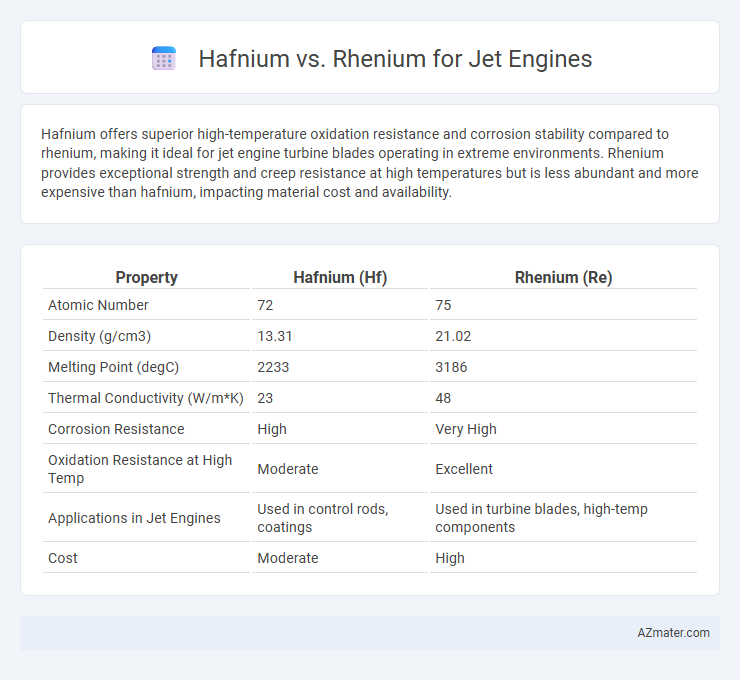Hafnium offers superior high-temperature oxidation resistance and corrosion stability compared to rhenium, making it ideal for jet engine turbine blades operating in extreme environments. Rhenium provides exceptional strength and creep resistance at high temperatures but is less abundant and more expensive than hafnium, impacting material cost and availability.
Table of Comparison
| Property | Hafnium (Hf) | Rhenium (Re) |
|---|---|---|
| Atomic Number | 72 | 75 |
| Density (g/cm3) | 13.31 | 21.02 |
| Melting Point (degC) | 2233 | 3186 |
| Thermal Conductivity (W/m*K) | 23 | 48 |
| Corrosion Resistance | High | Very High |
| Oxidation Resistance at High Temp | Moderate | Excellent |
| Applications in Jet Engines | Used in control rods, coatings | Used in turbine blades, high-temp components |
| Cost | Moderate | High |
Introduction to Hafnium and Rhenium in Jet Engines
Hafnium and rhenium are critical metals used in jet engines due to their excellent high-temperature strength and corrosion resistance. Hafnium enhances jet engine alloys primarily through its ability to improve oxidation resistance and maintain structural integrity at temperatures exceeding 1,200degC. Rhenium is prized for its remarkable melting point of 3,180degC and its capability to significantly increase the creep resistance and thermal stability of superalloys in turbine blades.
Material Properties: Hafnium vs Rhenium
Hafnium exhibits excellent corrosion resistance and high melting point of 2233degC, making it suitable for jet engine components subjected to extreme temperatures. Rhenium surpasses hafnium with an even higher melting point of 3186degC and exceptional creep resistance, critical for maintaining mechanical strength during prolonged engine operation. While hafnium offers good ductility and oxidation resistance, rhenium's superior thermal stability and toughness enhance durability in turbine blades and combustion chamber liners.
Melting Point and Thermal Stability Comparison
Hafnium and rhenium both play critical roles in jet engine components due to their high melting points and exceptional thermal stability, with hafnium melting at 2233degC and rhenium at a notably higher 3186degC, making rhenium more suitable for extreme temperature environments. The superior thermal stability of rhenium enables it to maintain strength and resist creep deformation under prolonged high-temperature exposure in jet engine turbine blades. Hafnium offers good oxidation resistance but is generally less effective in sustaining mechanical properties at temperatures exceeding 2000degC compared to rhenium, influencing material selection for critical high-temperature engine parts.
Oxidation Resistance in High-Temperature Environments
Hafnium exhibits superior oxidation resistance compared to rhenium, making it more effective in protecting jet engine components at temperatures exceeding 1200degC. Its stable oxide layer forms a durable barrier that prevents further degradation, whereas rhenium's oxide layers tend to be less protective and more prone to volatilization. This enhanced oxidation resistance contributes to increased engine longevity and efficiency in extreme high-temperature environments.
Mechanical Strength and Fatigue Resistance
Hafnium and rhenium exhibit distinct mechanical strength and fatigue resistance properties critical for jet engine applications, with rhenium offering superior high-temperature strength and excellent creep resistance, essential for turbine blades enduring extreme thermal stresses. Hafnium provides notable fatigue resistance and exceptional oxidation resistance, enhancing component lifespan under cyclic loading and corrosive environments. Rhenium alloys demonstrate enhanced fracture toughness, while hafnium contributes to improved thermal stability in composite materials used in jet engines.
Cost and Availability in Aerospace Manufacturing
Hafnium and rhenium are critical materials in jet engine manufacturing, with rhenium being significantly more expensive due to its rarity and complex extraction process, often costing several times more per kilogram than hafnium. Hafnium is more abundant and less costly, making it a more economical choice for aerospace applications where high-temperature resilience is necessary but extreme rarity is not critical. The limited availability of rhenium, primarily sourced from copper and molybdenum ores, constrains its supply and drives up costs, influencing manufacturers to balance performance requirements against budget constraints in high-performance engine components.
Applications of Hafnium in Jet Engines
Hafnium is primarily used in jet engines for its excellent high-temperature strength and corrosion resistance, making it an ideal component in turbine blades and combustion chamber liners. Its ability to form stable oxides at elevated temperatures improves thermal barrier coatings, enhancing engine efficiency and durability. Compared to rhenium, which is valued for its creep resistance in superalloys, hafnium excels in oxidation protection, crucial for extending the lifespan of critical jet engine parts.
Uses of Rhenium in Turbine Components
Rhenium is primarily used in jet engine turbine components due to its exceptional high-temperature strength and creep resistance, which enhance the durability and efficiency of turbine blades and vanes. Its ability to maintain mechanical stability at temperatures exceeding 1,700degC improves fuel efficiency and engine lifespan. Alloyed with nickel, rhenium significantly boosts the performance of superalloys, making it indispensable in high-pressure turbine sections of jet engines.
Environmental and Safety Considerations
Hafnium's superior oxidation resistance enhances jet engine safety by reducing high-temperature corrosion and extending component lifespan, minimizing environmental impact through less frequent replacements. Rhenium, while offering excellent high-temperature strength, poses greater environmental and health risks due to its scarcity and the toxicity of its extraction and processing. Selecting hafnium alloys supports sustainable aviation by lowering emissions related to material production and improving engine efficiency under demanding operating conditions.
Future Trends and Innovations in Jet Engine Materials
Hafnium and rhenium are critical materials in the advancement of jet engine technology due to their exceptional high-temperature stability and corrosion resistance. Innovations focus on developing hafnium-based superalloys and rhenium alloys that enhance turbine blade durability, enabling engines to operate at higher temperatures and improve fuel efficiency. Emerging trends include additive manufacturing techniques that optimize the microstructure of these metals, leading to next-generation jet engines with superior performance and reduced environmental impact.

Infographic: Hafnium vs Rhenium for Jet Engine
 azmater.com
azmater.com